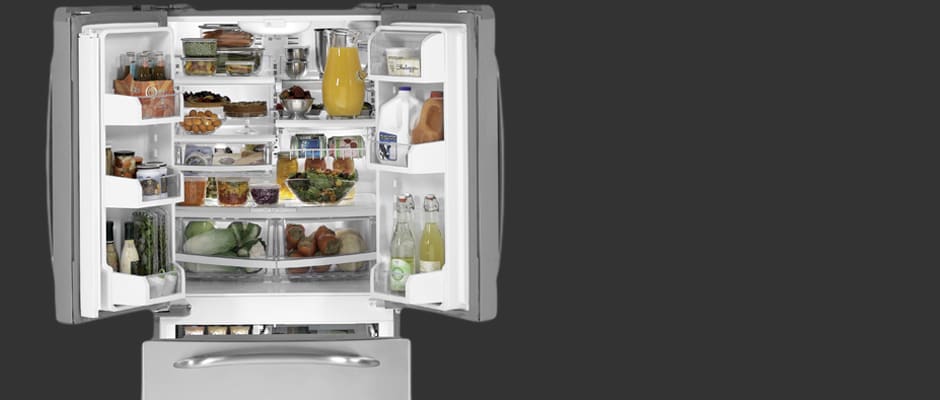Pros
Cons
Introduction
Front
{{section_header}}{{section.name}}{{/section_header}}
Like all French door models, this stainless steel appliance has two doors on top that open from the middle and reveal the interior of the fridge compartment. Below that is the drawer-like freezer, accessed by pulling out the large rectangular door. The left fridge door has an external water dispenser set below the control panel for the entire appliance.
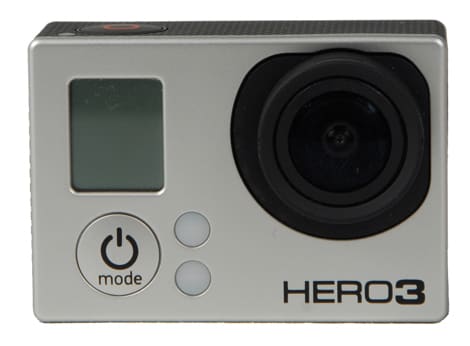
Like all stainless steel appliances, the {{product.brand.name}}{{product.brand.name}} is very prone to smudging. Fingerprints are very easily seen, especially if they go against the prominent horizontal grain in the steel finish.

As stated above, the control panel for both the interior of the appliance and the water dispenser are located on the outside of the left fridge door. There are buttons you can use to adjust the desired temperature, check the actual temperature, turn on the energy saving function, and several other features.

The handles are also stainless, but are finished with a vertical grain as opposed to the horizontal version found on the doors. Thankfully, they don't smudge as easily, either. The handles are thick and smooth, making them easy and comfortable to grip. While the handles on the fridge doors are vertically straight, the freezer handle curves down at both ends, giving the fridge a rather smug or disapproving appearance, depending on your imagination.

While many French door fridges combine the ice and water dispenser into one unit, this {{product.brand.name}}{{product.brand.name}} does not. The external dispenser is for water only, and is activated by pressing on the small paddle set just below the spout. The dispenser cavity is very shallow, so you won't be able to rest your glass while filling it. Its inexpensive plastic exterior looks somewhat out of place compared to the fridge's stainless finish.

Interior
{{section_header}}{{section.name}}{{/section_header}}
The inside of this appliance has a clean, utilitarian appearance. Glass shelves with white plastic trim don't make for a very exciting visual picture, but it looks as sturdy on the inside as it does on the out.
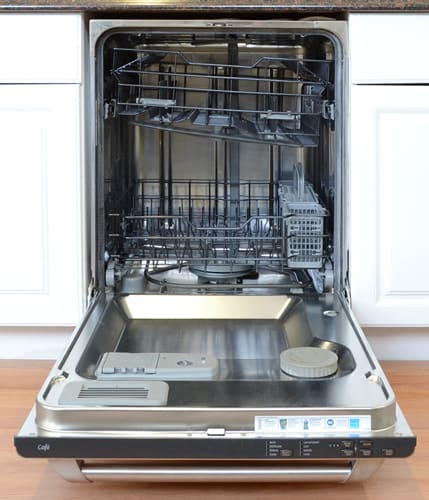
The interior of the CDWT980VSS.
The fridge uses four half-width shelves that mount on hooks in the rear, as well as a full-width shelf on the bottom that cannot be adjusted. There is also a deli drawer mounted to the bottom of a half shelf, and two vegetable drawers with independent humidity controls which mirror each other in design.
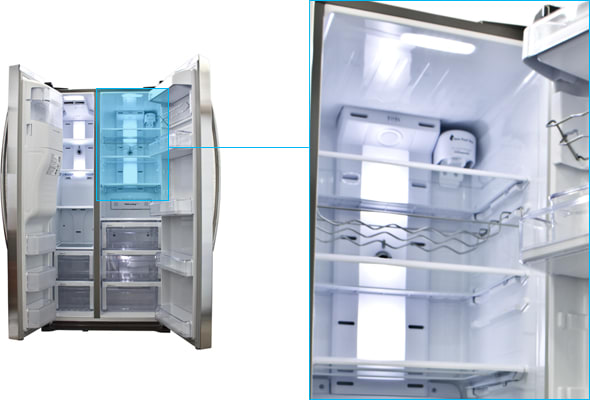
The water filter is located in the upper right corner at the back. It can be replaced by simply twisting it and pulling down.
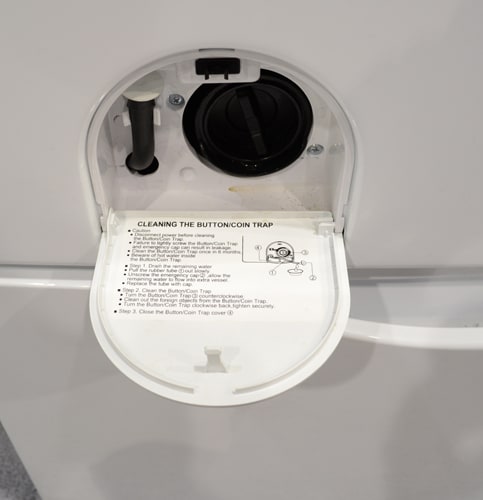
The left fridge door has three self-contained bucket shelves. The top two are identical and can be moved around to suit your needs. The bottom shelf is slightly smaller, though it's still large enough to comfortably hold a gallon-sized container.
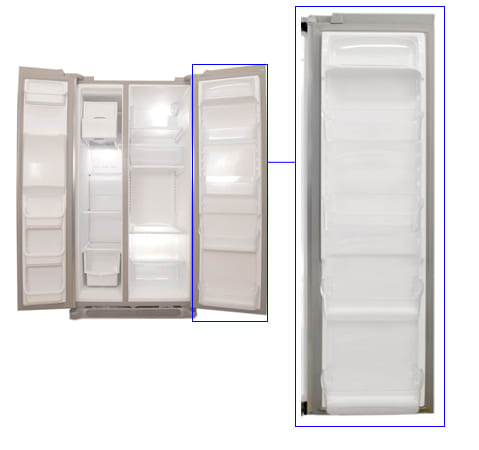
The door on the right is identical to the one on the left, with one exception. Instead of having two larger shelves, one is replaced by a dairy bin located at the top. This model comes with two small plastic dividers that can be attached to any of the five standard door shelves.
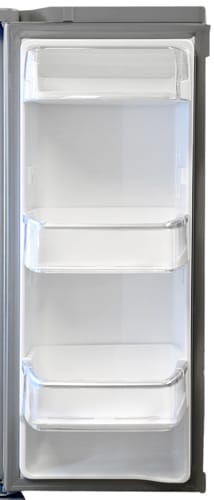
The door bins here are quite large, holding up to two gallons and four water bottles each.
The pull-out freezer uses plastic wire shelves, and is divided into four sections. Attached to the door and located at the bottom of the freezer is a large wire drawer that will hold the bulk of your frozen foods. Right above that is a short, full-width drawer labeled the "Slide N' Store", suitable for flat items like frozen pizzas and microwavable dinners. The top right is home to the "Full Slide Out" storage bin, a half-width wire drawer that can house all but the widest items. To its left is the ice maker, which has a cover that leaves a small amount of space available for tiny items such as pints of ice cream or ice packs.
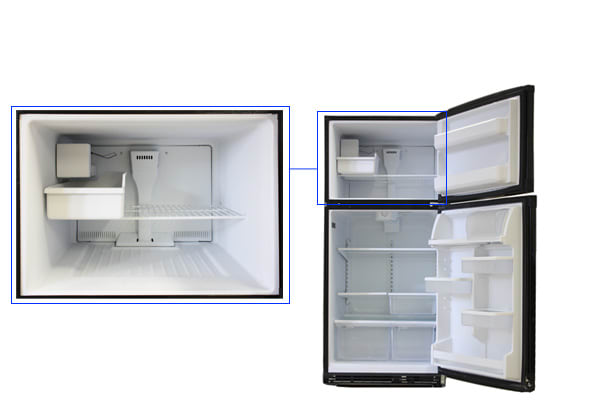
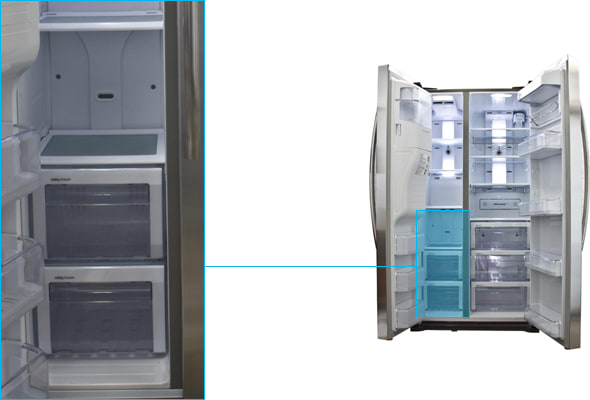
The ice maker is a self-contained unit that is controlled by flipping a switch on the device itself. Ice is stored in a pull-out bin set underneath the actual ice maker. It's rather small, meaning you have more room for actual food but may have to wait for ice if you have a party. Also, there's no ice dispenser on the front of the fridge, so you'll have to stoop and scoop if you want a cold beverage.
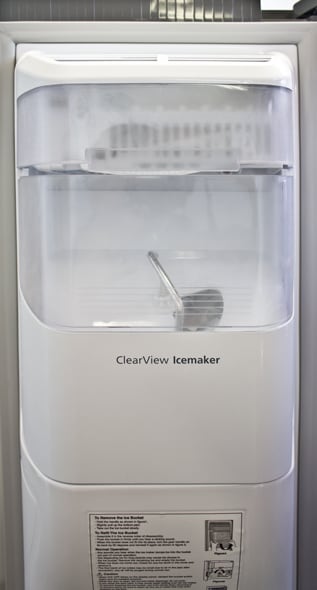
Back
{{section_header}}{{section.name}}{{/section_header}}
The {{product.brand.name}}{{product.brand.name}} has a very busy backside. It's a solid plate of metal, with four tubes on the back connecting the water supply to the filter, dispenser, and ice maker.
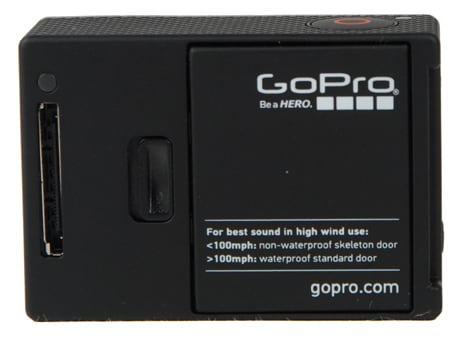
Sides
{{section_header}}{{section.name}}{{/section_header}}
The sides have a gray matte finish that matches the stainless front. If your kitchen keeps the sides of your fridge exposed, you'll take comfort in knowing that it won't look out of place.
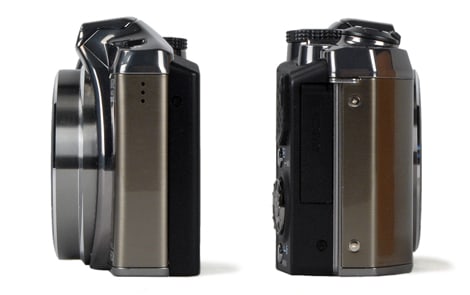
Olympus SZ-31MR iHS side views
Running Cost
{{section_header}}{{section.name}}{{/section_header}}
This {{product.brand.name}}{{product.brand.name}} will cost a consumer about $50.31 per year to operate, using a standard rate $0.09 per kW-h. This may seem like a lot, and it is true that this machine isn't a cheap one to operate. Compared to many other French door fridges of its size, however, this is actually a reasonable amount to pay.
Power Use Per Cu Ft
{{section_header}}{{section.name}}{{/section_header}}
The yearly operating cost may seem high, but we also test how much energy is used per cubic foot of storage space. We do this to create a comparable measurement between fridge sizes; a large fridge will usually use more energy than a smaller one, but that doesn't necessarily mean it's less efficient. This model uses about 0.12 kW-h per cubic foot, making its energy consumption lower than average. It's not the best on the market, but it's definitely on the more efficient end of the spectrum.
Fridge Temperature
{{section_header}}{{section.name}}{{/section_header}}
Despite having a wide open fridge, the temperature consistency from top to bottom wasn't as good as we'd hoped. The top of the fridge got as warm as 40 degrees Fahrenheit, while the middle of the fridge got as cool as 36. Keep in mind that the thermostat on the fridge said internal temperatures were at 37 degrees; you may want to turn it down a bit for ideal refrigeration temperatures. Either way, four degrees isn't a huge gap, but it's still big enough to take notice. You'll have to be careful about where you store your food, keeping items that are more perishable (such as soft cheese and yogurt) in the cooler portions. Luckily, temperatures remained very consistent over time, fluctuating less than a quarter of a degree on average.
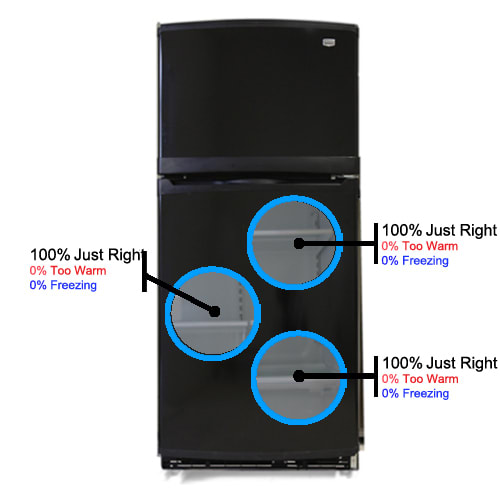
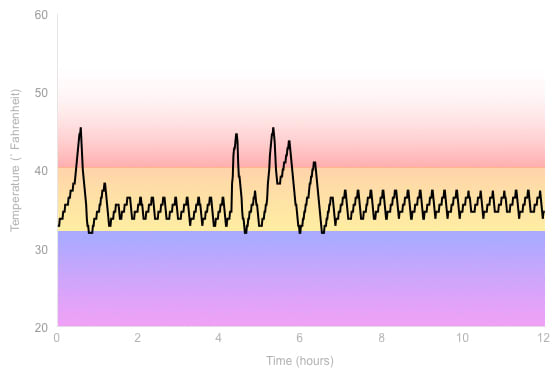
Freezer Temperature
{{section_header}}{{section.name}}{{/section_header}}
The freezer had similar problems to those found in the fridge, specifically a gap in temperature from top to bottom. You'd think that air flow between the open, wire shelves would keep things more consistent, but we pack it full of items that simulate the state of a typical consumer's freezer. With that said, the top of the freezer hovered around the ideal 0 degrees Fahrenheit, while the lower portion got up to about 3 degrees. Again, like the temperatures in the fridge, it's not a huge gap. Your food should in no way be affected by temperatures that low being only three degrees apart; it's simply a gap large enough to merit some attention. Temperatures also were quite consistent, fluctuating from about half to one quarter of a degree over time. That's a small enough difference that your food should be quite safe from freezer burn unless you plan to store things for a very long time.
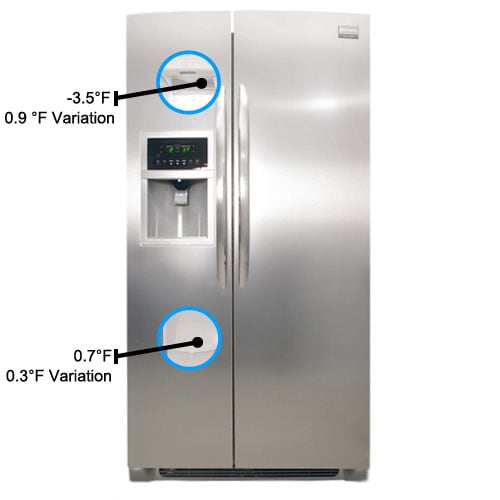
Vegetable Drawer
{{section_header}}{{section.name}}{{/section_header}}
Moisture retention in the {{product.brand.name}}{{product.brand.name}}'s vegetable drawer was excellent. At a rate of 0.15 grams per hour, water loss was exceptionally low; this means your fresh produce is likely to stay fresher for a longer period of time than in an average-quality appliance. If you like to buy lots of fruits and vegetables when they're on sale and eat them during the week, they may very well be almost as juicy or crispy as the day you bought them.
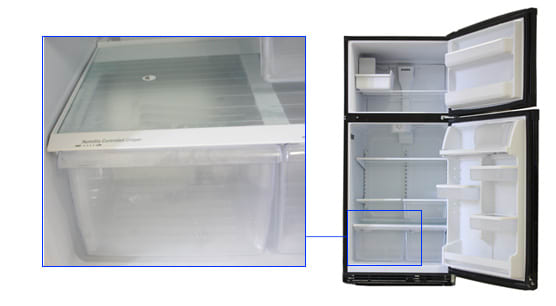
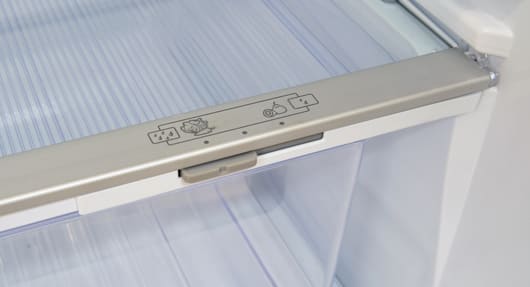
Power Loss
{{section_header}}{{section.name}}{{/section_header}}
After 36 hours without power, the {{product.brand.name}}{{product.brand.name}}'s freezer hadn't even broken 30 degrees. This appliance is sure to keep your food preserved for a power outage of average length, and the Turbo Cool feature will help to chill any items that have thawed for whatever reason.
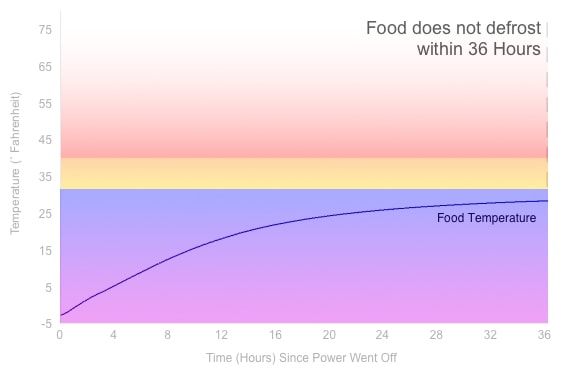
Freezing Performance
{{section_header}}{{section.name}}{{/section_header}}
It's perhaps a bit disappointing that this freezer took as long as it did to lower our room temperature items. Starting out at a heat level of about 71 degrees Fahrenheit, it took this appliance one hour and 41 minutes to bring it down to freezing. This is a bit longer than average, and could potentially effect the quality of food once thawed, especially meats.

Usable Space
{{section_header}}{{section.name}}{{/section_header}}
As with many French door freezers, this model uses mostly half-width shelves that mount to the rear of the cavity using hooks. There are four in total, with a fifth full-width shelf set above two crisper drawers located at the bottom. There is also a deli drawer affixed to one of the half shelves. All of these offer consumers a total of 9.96 cubic feet of usable space. This number takes into account space taken up by things such as light bulbs, the water filter, and all the shelves.
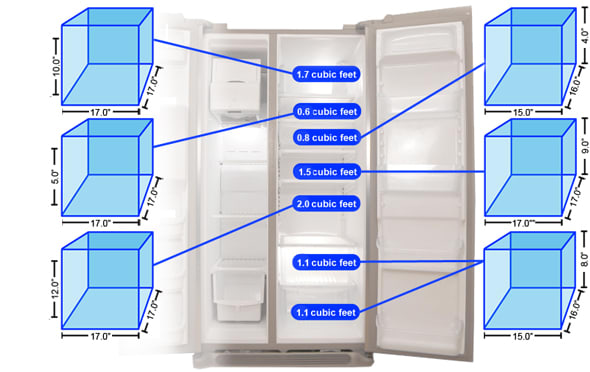
The left fridge door has three bucket shelves, the top two of which are adjustable. The third one, located at the bottom, is a bit smaller, but can still comfortably hold a gallon-sized container.
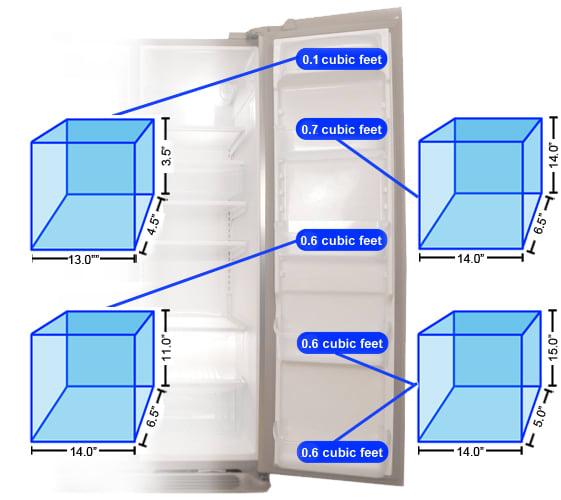
The right door is identical to the left, except it has a dairy bin on the top instead of another bucket shelf. Both doors contribute to the usable amount of storage listed above.
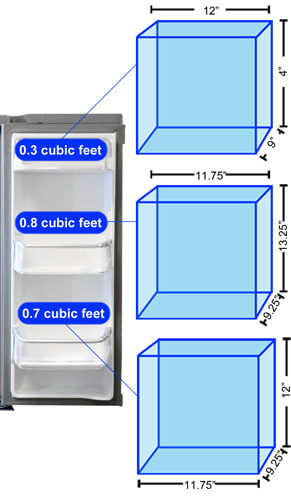
The pull-out freezer drawer provides four different storage spaces: the large wire bucket on the bottom, the short Slide N Store tray in the middle, the Full Slide Out half-width bucket on top, and a small space for lightweight items above the ice maker. It sounds like a lot, but altogether it amounts to just 2.85 cubic feet of usable storage.
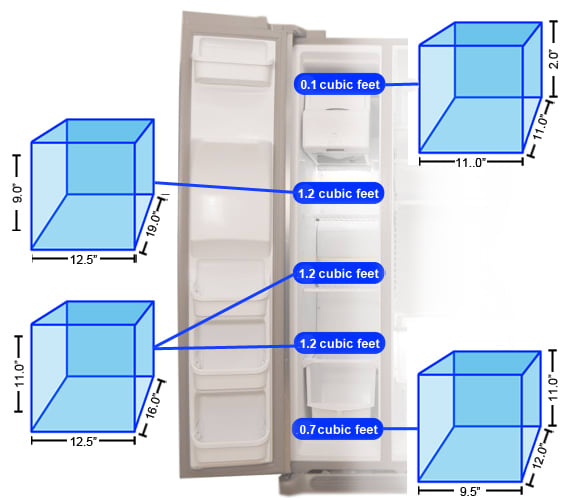
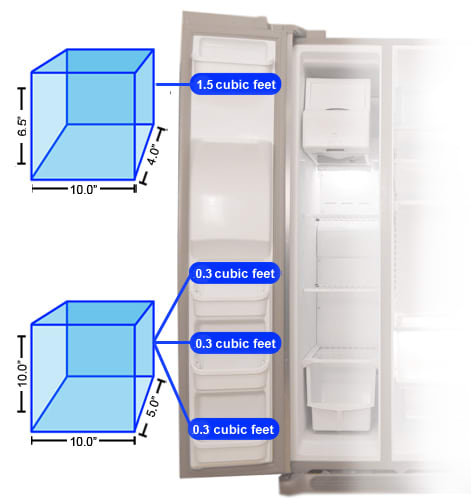
Below are the manufacturers own figures for capacity, and our own measurements for usable capacity. The manufacturers figures do not take account of the shelves, drawers and other removable features, but our measurements do account for the space these take up.
Ease of Access
{{section_header}}{{section.name}}{{/section_header}}
There is nothing terribly special about this particular French door fridge. The shelves are all reasonably accessible, except for whichever portion is directly under the deli drawer. The freezer should pose no problem except to consumers with bad backs or limited mobility issues. The only thing that's a pain to reach is the power switch to the ice maker, which is buried relatively far back inside the freezer.
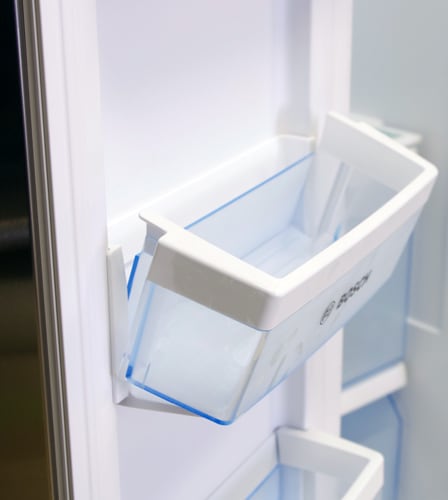
Controls
{{section_header}}{{section.name}}{{/section_header}}
As stated above, the control panel for both the interior of the appliance and the water dispenser are located on the outside of the left fridge door. There are buttons you can use to adjust the desired temperature, check the actual temperature, turn on the energy saving function, and several other features.
The controls are intuitive, clearly labeled, and quite responsive. There's nothing on the instrument panel that's unusually confusing or poorly made that should hamper a consumer's experience with this fridge. It comes with a few extra functions that include an energy saving option and a Turbo Cool, which puts the fridge into a state of fast chill. The manual states this is ideal for refrigerating warm food or restoring your ideal temperature quickly after a power outage has ended.

Water Dispenser
{{section_header}}{{section.name}}{{/section_header}}
While the water dispenser itself has no issues doing what it's supposed to, the paddle can be a bit frustrating if you're not paying attention. It hardly depresses at all, which means you're more likely to turn it on unless you activate the control lock. The filter, pleasantly enough, is quite easy to change, and fairly simple to get to as long as you don't have piles of food in front of it.

Ice Maker
{{section_header}}{{section.name}}{{/section_header}}
The ice maker is a self-contained unit that is controlled by flipping a switch on the device itself. Ice is stored in a pull-out bin set underneath the actual ice maker. It's rather small, meaning you have more room for actual food but may have to wait for ice if you have a party. Also, there's no ice dispenser on the front of the fridge, so you'll have to stoop and scoop if you want a cold beverage.

Cleaning
Noise
Other Features
{{section_header}}{{section.name}}{{/section_header}}
{{product.manufacturer_specs['Other Features Photo BROKEN?']}}
Conclusion
Energy Efficiency
It's going to cost you a pretty penny to run, which is standard for fridges of this size. Nevertheless, it's actually quite energy efficient, so you'll know that electric bill is justified.
Performance
Some wonky temperature issues in both the fridge and freezer keep this appliance from getting perfect marks. There aren't any huge issues, though, and the temperature disparities are low enough to be offensive more on principle than anything else. Excellent moisture retention is a big plus, though freezing times were slower than average.
Storage Space
A relatively spacious fridge is good for lovers of fresh produce, but the freezer is smaller than on other models of similar size.
Usability
There were three big sticking points as far as this fridge was concerned: wire drawers in the freezer offer no spill protection whatsoever, ice isn't dispensed through the door and the ice maker is a pain in the neck to reach (though the ice tray itself is easily removable), and the deli drawer in the fridge can effectively block off storage for the shelf space directly under it. Otherwise, it uses a very traditional layout and shouldn't pose any additional problems to consumers.
Meet the tester
Matthew is a native of Brockton, MA and a graduate of Northeastern, where he earned a degree in English and Theatre. He has also studied at the Gaiety School of Acting in Dublin and spends most of his free time pursuing a performance career in the greater Boston area.
Checking our work.
Our team is here to help you buy the best stuff and love what you own. Our writers, editors, and experts obsess over the products we cover to make sure you're confident and satisfied. Have a different opinion about something we recommend? Email us and we'll compare notes.
Shoot us an email